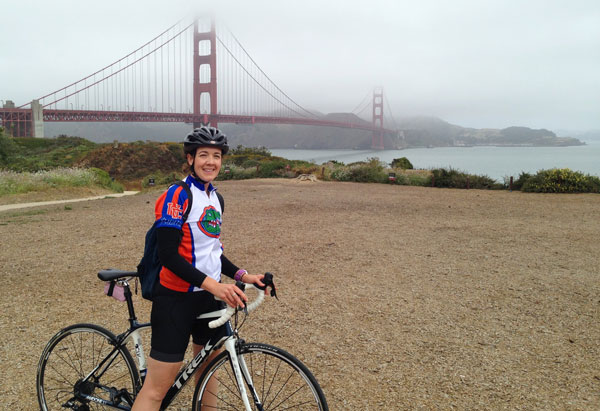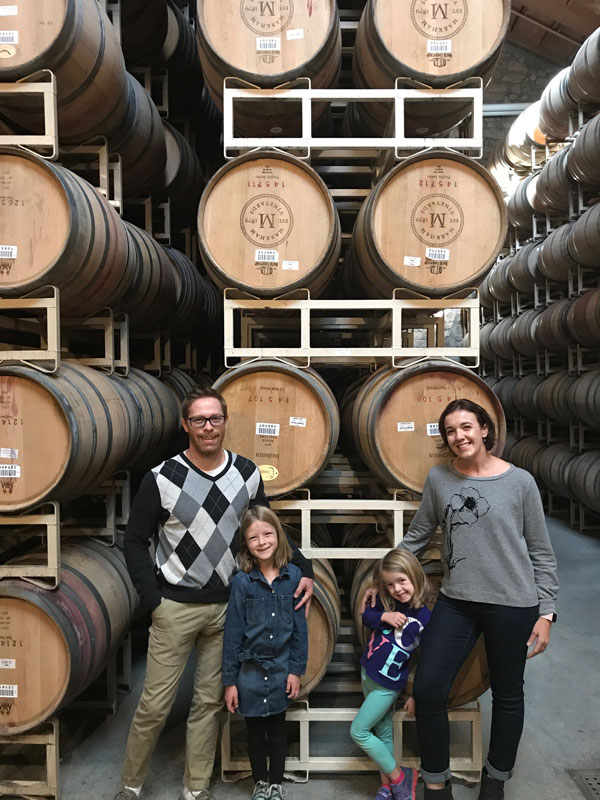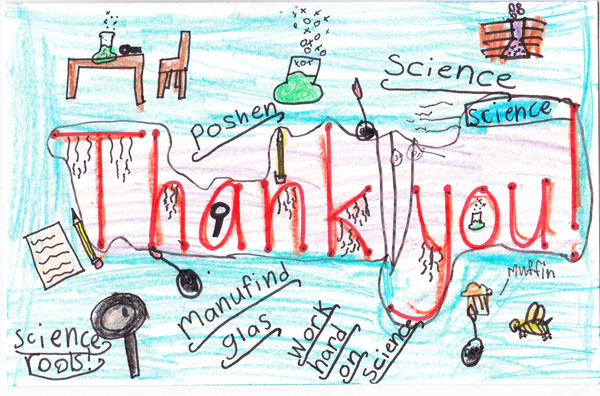A story of finding, leaving and returning to Sandia

Sandia is Spanish for watermelon, which is the same color as the alluring pink mountains in New Mexico our laboratories are named after. Sandia as a company has its own allure, especially for manager and University of Florida alumnus Marie Kane.
The national security mission, engaging work, friendly culture and excellent work/life balance are all factors that brought Kane not once but twice to Sandia’s door.
On course to California
Kane’s path to the labs started in Orlando. Growing up she took after her father, a Disney World electrical engineer, and was attracted to aspects of his career path. “I knew I didn’t really enjoy taking apart the toaster, but I liked the application focus and problem solving associated with engineering,” she said. She also excelled in her high school chemistry courses, making a bachelor’s degree in chemical engineering a natural choice.
But as a clarinet player, she was torn between science and music. Luckily, the University of Florida allowed her to immerse herself in both passions. Kane minored in music performance, and got to study one-on-one with a clarinet professor who quit the New York Philharmonic Orchestra and traded the big city for gator country. “I lucked out,” she said. “These days his clarinet studio is so full they don’t accept music minors anymore.”
After college, Kane says she wasn’t immediately planning on going to graduate school, but her job interviews were underwhelming. One of her post-college offers was at a paper mill in Florida. “The scent of the chemicals they use is so strong you can smell it from miles away,” Kane said. “So… not appealing.”
The scarcity of options made it easy for her to decide to return to school. After graduating with her PhD in materials science, her next stop was Savannah River National Laboratory, where she spent three years as a staff scientist working on nuclear materials and battery technologies – some of her biggest research interests.
Watermelon to Apple
Ultimately, Kane felt that South Carolina was not where she wanted to raise her growing family. So, when the opportunity to continue working on similar technologies for Sandia in California presented itself in 2010, she jumped.
Hired into the Materials Chemistry department as a staff member, Kane soon found herself managing that department, and then moved into managing the Remote Sensing group. Though she enjoyed the work, she continued to feel a pull toward energy work. “I drive an electric car. I really love electric vehicles, and the batteries that power those vehicles. And a lot of the battery technologies can be leveraged and used for other applications that we care about at Sandia,” she said.
When she described her passion for energy storage to a Sandia colleague, they offered to shoot her resume to a recruiter for Apple. She said she didn’t expect much to come of it, but sent her resume anyway, and it turned out Apple – all of whose products contain batteries – was very interested. “It’s not every day the largest tech company in the world asks you to come work for them. And in my technical area of passion – I felt like I couldn’t pass it up.”
Not enough energy stored
In February of 2017 Kane left Sandia for Apple. It only took her six months to decide to return to Sandia. When asked why she came back, she says, “I tell people that Apple is everything Sandia isn’t.”
Some of the differences just seemed strange after so many years with the national laboratories. “The guy behind me had this little mini fridge under his desk. I asked if he kept his lunch in there. He said, ‘No, it’s the beer fridge.’ People openly had bottles of wine out on their desk. I even saw a director crack a beer after a meeting – inside the building – in the middle of the day. I asked him, ‘Good day or bad day?’ And he responded, ‘Does it matter?’ I suppose it didn’t.”
Other differences were less amusing to her. Whereas most Sandians leaving the office around 5 p.m. and leaving work behind until the next morning is perfectly acceptable, Apple employees work all hours of the day and night.

“I got text messages at midnight and I was expected to respond even if I was in bed already.”
A typical day would see Kane through three-plus hours of commuting to and from the office, coming home to make dinner and take care of her two daughters, and then get back on her computer to do a second shift, working until she went to bed.
It often felt to Kane like her department at Apple was constantly in crisis mode. She would start most days wondering, “What fire are we putting out now? What thing is someone going to ask for that has to be done an hour ago?” This kind of stress took its toll.
The turning point was Kane’s husband telling her point blank, “I don’t like the person you’ve become.” She wasn’t offended, because she agreed with him. She had been shorter with her kids, constantly feeling guilty about spending less time with them, living in a constant state of exhaustion, unable to do a lot of the things she loves.
She realized too that while it was cool to tell her friends she was working on the battery for the next iPhone or iPad, she missed the sense of pride she felt doing work that affects our nation’s security.
Sanity returns
Now that she’s back, Kane is managing people in multiple different nuclear weapons programs, and she loves it. “It’s been great. I have project managers in anything from components to stockpile systems. It gives me the opportunity to poke my nose into all these different areas, some of which I haven’t been as exposed to during my career as a staff member in NW programs. It’s been super interesting,” she said.
One thing she really wants to impress on Sandians who look out on the tech world with curiosity or even envy is how impressed her Apple colleagues were with the laboratories’ work.
“I think people here, especially ones that have spent their entire career at Sandia, look out onto Silicon Valley tech companies and think what they’re doing is so fast paced and cool. But you have to realize there are a lot of people at those companies looking in on us going ‘Man, what they have, all these great, smart people working on a super important national security mission.’ Going to Apple gave me that reverse perspective.”
Kane succinctly explained the net effect on her life of returning to Sandia. “Sanity returned,” she said. She now has the time to play her clarinet, ride her bike, take a ballet class, volunteer in her kid’s elementary science classes, or just sit in her backyard, savoring watermelon.

HAVING RETURNED TO SANDIA, Marie now has time to volunteer in her daughter’s elementary school science classes on her 9/80 Fridays off.